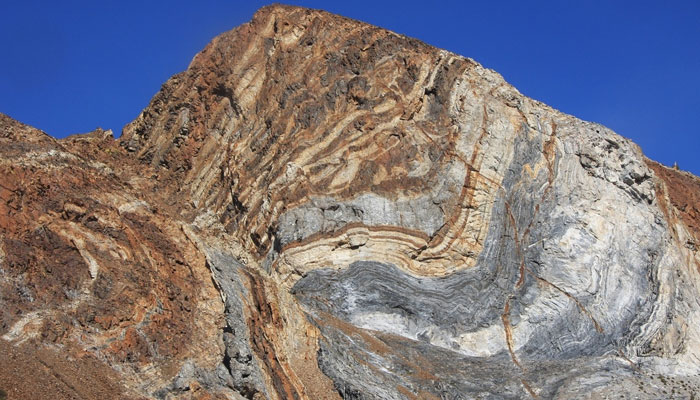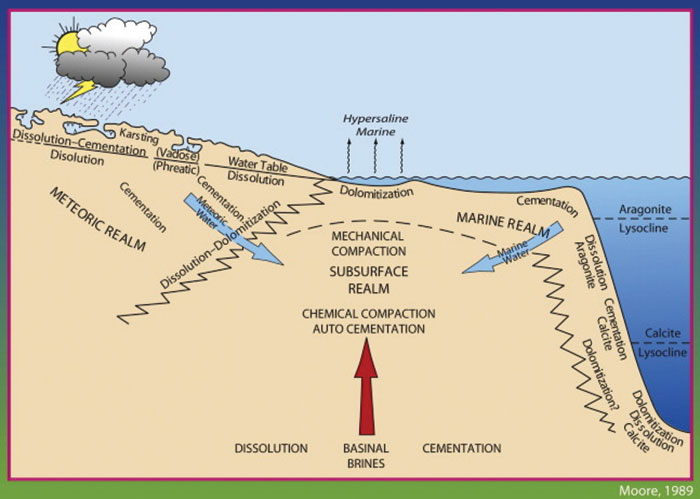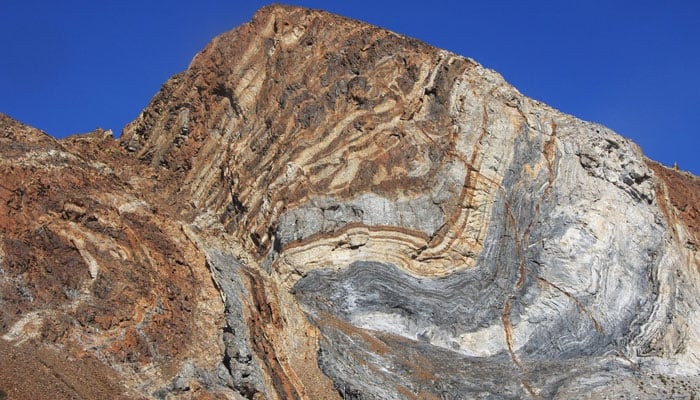
“Diagenesis” or double creation is actually the necessary consequence of the change of physical and chemical environment, from which each sediment is deposited and each juvenile sediment is deposited on top of it after burial (deepening). passes Because the atmosphere below the surface of the earth is completely different from the atmosphere on the surface in many of its characteristics. Therefore, the mineral particles present in this sediment undergo various changes to adapt to their changed environment.
For example, during initial sedimentation (before going to depth) the impermeable water-bearing “clay” of Mount Morello Night changes to durable “shale” and burial (after going to depth) to durable mica-like clay (illite). becomes When this process reaches its logical limit, it results in a durable sedimentary rock that holds a very important position in natural resources, especially oil and gas, and storage and exploration. Persistence here means that any mineral or substance exists when, despite the passage of a sufficient period of time, it cannot interact with another substance or change into a new mineral or substance.
In order to reveal all these hidden facts, the term “Resurrection” was first introduced by a German geologist, Von Gumball, in 1889 among the scientific circles and expressed the idea that underground The physical and chemical changes that occur in the sedimentary environment during the deposition of a juvenile sediment are called the process of “deposition”.
Despite the passage of almost a century since this term was introduced in geological science, there is still a significant difference of opinion among “geologists” regarding this concept and its correct history, because ” Along with the ‘repetition’ process, there is another process associated with it which is called the process of ‘Metamorphism’.
But there is a clear difference between the two. The first thing in this regard is that the process of “regeneration” is limited to a shallow depth underground, while the process of “transformation” takes place much deeper than that. Therefore, scientists have been constantly engaged in efforts to define the boundary between the processes of “replication” and mutation, which resulted in a well-known contemporary paleontologist, P.T. John (Pettyjonn) described all the changes that take place in a sediment before deposition and after burial. Highlighted its two aspects.
In this context, the first aspect explains the fact that during “metamorphism” the initial differences in the composition and mineral composition of the source rock are almost eliminated and a homogeneous (homogenous) metamorphosed rock is exposed. occurs while “reweaving” makes this difference in the source rock even greater and more prominent. For example, if a clay-bearing calcium carbonate (limestone) is present, the clay minerals in it will change during the metamorphosis process in such a way that the rock will change into marble, but the clay minerals will pass through the process of recrystallization within it. . In contrast, if a silica-bearing limestone undergoes “weathering,” the silica in it is dissolved and precipitated, resulting in nodules and streaks of chert.
(Press and Save Earth) in 1977 confirms that the duration of the “regeneration” process varies under different conditions. It usually begins when a sedimentary layer is deposited on top of another sedimentary layer. Thus the previous layer is disconnected from its environment and this process continues (temperature 300 degrees Celsius and depth 5.5 km) until the temperature and depth increase. When the temperature exceeds 300 degrees Celsius and the depth exceeds 6.5 km, then the metamorphism process begins.
In this environment, an early period of “degradation” can often be observed when the sediments are not yet completely buried and remain in direct contact with seawater. During this stage, the changes that occur in the sedimentary material. The term “Halmyrolysis” is used for this.
This can be inferred when juvenile muds and sands are compared with older folded shale and sandstones, both of which change in composition and texture after deposition under the influence of many factors. And as a whole, they turn into “lumps” which is called “physical regrowth”.
It usually hardens the soft sediment to form durable rock. That is, they become layered. This process also alters the mineral composition and forms some new minerals. The major “physical recrystallization” process is through “coalescence,” during which the distance between older particles is reduced by the weight of younger sediments. And the sediments become closer and closer to each other, causing a significant reduction in sediment volume and consequently a reduction in the pores in it.
For example, mud that settles in juveniles has a very high porosity. It contains a very large amount of water (60 percent), then the water is released by the process of “solidification” and, under further pressure, turns into a durable sedimentary rock called “shale”. goes A large decrease in porosity in any sediment also occurs when mineral particles are deposited between the interparticle spaces by the process of “rewetting”.
In contrast, all the changes that occur after burial of the particles when they are separated from the sea water are called “metamorphesis”, in which two types of changes are observed. Is. The first trend is between equilibrium (stable) and nonequilibrium (unstable) mixtures that contain minerals of different compositions derived from rocks of different composition and with sediment broken up during sedimentation. They mix.
For example, calcite added from the environment during chemical precipitation. Thus, during sedimentation, the mixture of two different minerals that belong to two separate source rocks (igneous rocks). These minerals in the form of mixtures exist in complete contrast to their environment of formation. For example: Sodium-carrying plagio-cleaner feldspar is added from “granite” rock and calcium-carrying plagio-cleaner “basalt”. The chemical recrystallization process dissolves the calcium-bearing feldspar and precipitates the sodium-bearing feldspar. In this way the rock tends to chemical equilibrium, resulting in a homogeneous more durable playgo cleaner composition.

Another example of asymmetry is a carbonate precipitate called “aragonite” which spontaneously changes to calcite after a long period of time. It is a type of calcium carbonate which is stable at low temperature and pressure. This equilibrium trend results in chemical reactions between unstable minerals that create other new minerals, and thus a rock of a stable composition is exposed. While the second trend is related to sediment deposition and burial. which is associated with greater crustal depth.
When a sediment is buried, it is exposed to high temperatures. That is an average depth of 30 meters at one degree Celsius and a high pressure of 4.4 meters at an average atmospheric pressure. When groundwater around minerals and pores becomes extremely hot and under high pressure, it is capable of chemical reactions within it. If this process continues for a long period of time, then the process of “variation” completely dominates. This is the point at which a demarcation of more than 300 degrees Celsius can be drawn between the process of “repetition” and variation.
Mineral (oil and gas) and groundwater exploration and recovery have a special place in practice, because their recovery from any rock formation depends on the nature of the porosity in the rock formation. Is. If more, it is profitable, which is analyzed by “repetitive binding”.
It is also a fact that sediments usually contain organic remains. At about 0-120 degrees Celsius and 0-2.5 km below the Earth’s surface, this organic residue undergoes a variety of chemical and microbiological changes, as a result of which all available oxygen is used up.
As a result, carbon dioxide, methane and hydrogen sulfide are produced in abundance. When these gases dissolve in the water within the sediment, a reducing environment is created, allowing the creation of reducing bacteria that gradually convert the organic matter into oil and gas, or both, at varying temperatures and pressures. .
Wetlands have a “reduced” environment where the process of organic matter recycling can be directly observed, as organic matter is buried underground by mosses and ferns and trapped plants and trees are hard and brown in color. are transformed, in which the plant roots and seeds are clearly visible, which is called peat, i.e. primary coal, which is the first product of the recycling process.
But with the evolution of time, these marshy areas sink into soft soil and with the increase in temperature, peat becomes harder and turns into lignite. Enters the limits of “transformation” then changes to form anthracite, graphite. It is the end result of the transformation while the transformation process is followed by the re-melt limitation. Where all organic and inorganic matter melts and becomes an integral part of the “terrestrial fluid”.
setTimeout(function(){
!function(f,b,e,v,n,t,s)
{if(f.fbq)return;n=f.fbq=function(){n.callMethod?
n.callMethod.apply(n,arguments):n.queue.push(arguments)};
if(!f._fbq)f._fbq=n;n.push=n;n.loaded=!0;n.version=’2.0′;
n.queue=[];t=b.createElement(e);t.async=!0;
t.src=v;s=b.getElementsByTagName(e)[0];
s.parentNode.insertBefore(t,s)}(window,document,’script’,
‘https://connect.facebook.net/en_US/fbevents.js’);
fbq(‘init’, ‘836181349842357’);
fbq(‘track’, ‘PageView’);
}, 6000);
/*setTimeout(function(){
(function (d, s, id) {
var js, fjs = d.getElementsByTagName(s)[0];
if (d.getElementById(id)) return;
js = d.createElement(s);
js.id = id;
js.src = “//connect.facebook.net/en_US/sdk.js#xfbml=1&version=v2.11&appId=580305968816694”;
fjs.parentNode.insertBefore(js, fjs);
}(document, ‘script’, ‘facebook-jssdk’));
}, 4000);*/
const jqueryIntervalcount = setInterval(function () {
if(typeof jQuery !== “undefined”){
clearInterval(jqueryIntervalcount);
if(jQuery(‘.infogram-embed’).length > 0 || jQuery(’embedinfogram’).length > 0)
{
!function (e, t, n, s) {
var i = “InfogramEmbeds”, o = e.getElementsByTagName
if (/^\/{2}/.test(s) && (s = d + s), window[i] && window[i].initialized)window[i].process && window[i].process(); else if (!e.getElementById(n)) {
var a = e.createElement
a.async = 1, a.id = n, a.src = s, o.parentNode.insertBefore(a, o)
}
}(document, “script”, “infogram-async”, “https://e.infogram.com/js/dist/embed-loader-min.js”);
}
if($(‘.apester-media’).length > 0)
{
var scriptElement=document.createElement(‘script’);
scriptElement.type=”text/javascript”;
scriptElement.setAttribute=”async”;
scriptElement.src=”https://static.apester.com/js/sdk/latest/apester-sdk.js”;
document.body.appendChild(scriptElement);
}
if($(‘.twitter-tweet’).length > 0)
{
var tweetObj = document.getElementsByClassName(‘tweetPost’);
var counter_tweet = 0;
if (tweetObj.length == 0) {
tweetObj = document.getElementsByClassName(‘twitter-tweet’);
$.each(tweetObj, function (i, v) {
$(this).attr(‘id’, ‘twitter-post-widget-‘ + i);
});
} else {
$.each(tweetObj, function (i, v) {
if($(this).find(‘.twitter-tweet’).length > 0){
$(this).find(‘.twitter-tweet’).attr(‘id’, ‘twitter-post-widget-‘ + counter_tweet);
counter_tweet++;
}
});
}
$.getScript(‘https://platform.twitter.com/widgets.js’, function () {
var k = 0;
var tweet = document.getElementById(‘twitter-post-widget-‘ + k);
var tweetParent, tweetID;
while (tweet) {
tweetParent = tweet.parentNode;
//tweetID = tweet.dataset.tweetId;
tweetID = tweetParent.getAttribute(“id”);
if(tweetID === null){
tweetID = tweet.dataset.tweetId;
}
//var tweetVideoClass = tweet.getAttribute(‘class’).split(‘ ‘)[0];
$(tweet).remove();
twttr.widgets.createTweet(
tweetID,
tweetParent
);
k++;
tweet = document.getElementById(‘twitter-post-widget-‘ + k);
}
});
/*==============*/
var tweetObjVid = document.getElementsByClassName(‘tweetVideo’);
var counter_tweet = 0;
if (tweetObjVid.length == 0) {
tweetObjVid = document.getElementsByClassName(‘twitter-video’);
$.each(tweetObjVid, function (i, v) {
$(this).attr(‘id’, ‘twitter-vid-widget-‘ + i);
});
} else {
$.each(tweetObjVid, function (i, v) {
if($(this).find(‘.twitter-video’).length > 0){
$(this).find(‘.twitter-tweet’).attr(‘id’, ‘twitter-vid-widget-‘ + counter_tweet);
counter_tweet++;
}
});
}
$.getScript(‘//platform.twitter.com/widgets.js’, function () {
var v = 0;
var tweetVid = document.getElementById(‘twitter-vid-widget-‘ + v);
var tweetParentVid, tweetIDVid;
while (tweetVid) {
tweetParentVid = tweetVid.parentNode;
//tweetIDVid = tweetVid.dataset.tweetId;
tweetIDVid = tweetParentVid.getAttribute(“id”);
if(tweetIDVid === null){
tweetIDVid = tweet.dataset.tweetId;
}
$(tweetVid).remove();
twttr.widgets.createVideo(
tweetIDVid,
tweetParentVid
);
v++;
tweetVid = document.getElementById(‘twitter-vid-widget-‘ + v);
}
});
}
if($(‘.instagram-media’).length > 0){
var scriptElement=document.createElement(‘script’);
scriptElement.type=”text/javascript”;
scriptElement.setAttribute=”async”;
scriptElement.src=”https://platform.instagram.com/en_US/embeds.js”;
document.body.appendChild(scriptElement);
}
if($(‘.tiktok-embed’).length > 0){
var scriptElement=document.createElement(‘script’);
scriptElement.type=”text/javascript”;
scriptElement.setAttribute=”async”;
scriptElement.src=”https://www.tiktok.com/embed.js”;
document.body.appendChild(scriptElement);
}
if($(‘.fb-video’).length > 0 || $(‘.fb-post’).length > 0){
var container_width = $(window).width();
if(container_width 0){
let embed_url = $(‘.fb-video’).attr(‘data-href’);
let htmla=”
‘;
$(‘.fb-video’).parent(‘.embed_external_url’).html(htmla);
}
else{
let embed_url = $(‘.fb-video’).attr(‘data-href’);
let htmla=”
‘;
}
}
var scriptElement=document.createElement(‘script’);
scriptElement.type=”text/javascript”;
scriptElement.setAttribute=”async”;
scriptElement.src=”https://connect.facebook.net/en_US/sdk.js#xfbml=1&version=v2.11&appId=580305968816694″;
document.body.appendChild(scriptElement);
}
}
},100); var story_embed_gallery = $(‘.detail_gallery’).find(‘.embedgallery’).length;
if(story_embed_gallery > 0){
var styleElement=document.createElement(‘link’);
styleElement.type=”text/css”;
styleElement.rel=”stylesheet”;
styleElement.href=”https://jang.com.pk/assets/front/css/swiper-bundle.min.css”;
document.head.appendChild(styleElement);
var styleElement=document.createElement(‘link’);
styleElement.type=”text/css”;
styleElement.rel=”stylesheet”;
styleElement.href=”https://jang.com.pk/assets/front/css/colorbox.css”;
document.head.appendChild(styleElement);
}
if($(“#theNewsWidget”).length > 0){
$(“#theNewsWidget”).load(“https://www.thenews.com.pk/get_entertainment_news_widget”);
}



